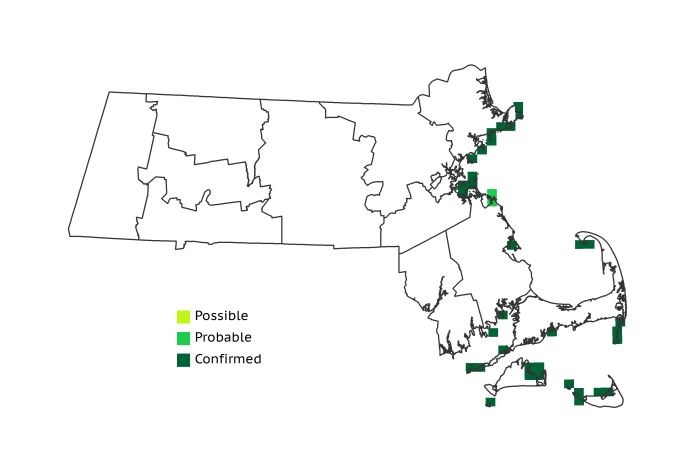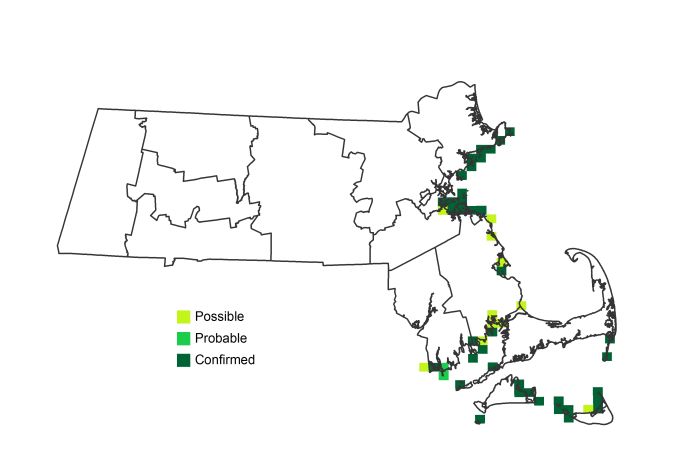Breeding Bird Atlases (BBA)
Find a Bird
Great Black-backed Gull
Larus marinus

Local and likely increasing
Action/monitoring needed
“the islet it had chosen for its home was deserted and shunned by other less aggressive waterfowl, for no other nest was safe about the castle of this robber baron”— Arthur Cleveland Bent, Life Histories of North American Birds
Easily recognized by its dark mantle and large size, the so-called “King of Gulls” earned its nickname by being the biggest, baddest, and meanest gull on the block. The Great Black-backed Gull’s reputation is built on its apparent bullying of smaller gulls and terns, as well as it voracious appetite for the eggs and young of other shorebirds. Formerly unheard of as a breeding species in the Commonwealth, the Great Black-backed Gull can now be seen fairly often amongst flocks of its more diminutive cousins.
Historic Status
The world's largest gull species was not a breeder in Massachusetts until 1931, when a single nest was found in Salem. Until that time, it was known primarily as a migrant and a winter resident, and a breeder from Nova Scotia northward. The spread southward heralded a rebound of the species whose decimation was caused by feather and egg collectors in the nineteenth century. In 1941, more southward-moving pioneers settled the Wepecket Islands in the Elizabeth Island chain in Buzzards Bay, and by the 1970s the settlement of the state’s coastline was complete, with at least 3,000 pairs known to be nesting in Massachusetts.
Atlas 1 Distribution
Presumably gorging on fishing waste and the collective offal of local dumps and landfills, Great Black-backed Gulls were well established along the Massachusetts coastline as of Atlas 1. The Coastal Plains had several occupied blocks along the North Shore, as well as one in Plymouth. The six Boston Basin blocks, mostly clustered in and around Boston Harbor, underscored this species’ association with humans and the food they provided. Not surprisingly, for a colonial-nesting seabird looking for offshore island real estate, no ecoregion could surpass the Cape and Islands for nesting opportunities. Great Black-backed Gulls were found in nearly 20 Cape & Islands blocks in Atlas 1 – more than in all of the other regions combined. Two Buzzards Bay blocks in the Bristol/Narragansett Lowlands rounded out the Atlas 1 distribution of this species.
Atlas 2 Distribution and Change
Studies comparing the number of breeding pairs of Great Black-backed Gull from 1994-95 to those from 2006-08 revealed a 40% decline (see table), a pattern similar to that noted for the Herring Gull. Great Black-backed Gulls were found in more blocks during Atlas 2 compared to Atlas 1, but this is a less reliable measure of the trend of this species when compared to the direct colony counts. Melvin (2010) notes that the pattern of decline seen in Massachusetts for both Herring and Great Black-backed Gulls is mirrored by the results of surveys conducted along the New Hampshire and Maine coasts.
Atlas 1 Map

Atlas 2 Map

Atlas Change Map

Ecoregion Data
Atlas 1 | Atlas 2 | Change | ||||||
Ecoregion | # Blocks | % Blocks | % of Range | # Blocks | % Blocks | % of Range | Change in # Blocks | Change in % Blocks |
Taconic Mountains | 0 | 0.0 | 0.0 | 0 | 0.0 | 0.0 | 0 | 0.0 |
Marble Valleys/Housatonic Valley | 0 | 0.0 | 0.0 | 0 | 0.0 | 0.0 | 0 | 0.0 |
Berkshire Highlands | 0 | 0.0 | 0.0 | 0 | 0.0 | 0.0 | 0 | 0.0 |
Lower Berkshire Hills | 0 | 0.0 | 0.0 | 0 | 0.0 | 0.0 | 0 | 0.0 |
Vermont Piedmont | 0 | 0.0 | 0.0 | 0 | 0.0 | 0.0 | 0 | 0.0 |
Berkshire Transition | 0 | 0.0 | 0.0 | 0 | 0.0 | 0.0 | 0 | 0.0 |
Connecticut River Valley | 0 | 0.0 | 0.0 | 0 | 0.0 | 0.0 | 0 | 0.0 |
Worcester Plateau | 0 | 0.0 | 0.0 | 0 | 0.0 | 0.0 | 0 | 0.0 |
Lower Worcester Plateau | 0 | 0.0 | 0.0 | 0 | 0.0 | 0.0 | 0 | 0.0 |
S. New England Coastal Plains and Hills | 9 | 3.3 | 25.0 | 9 | 3.2 | 17.6 | 1 | 0.4 |
Boston Basin | 6 | 10.7 | 16.7 | 11 | 19.6 | 21.6 | 5 | 9.1 |
Bristol and Narragansett Lowlands | 2 | 1.9 | 5.6 | 9 | 7.9 | 17.6 | 4 | 4.0 |
Cape Cod and Islands | 19 | 14.0 | 52.8 | 22 | 15.3 | 43.1 | 3 | 2.5 |
Statewide Total | 36 | 3.7 | 100.0 | 51 | 4.9 | 100.0 | 13 | 1.6 |
Notes
The rapid expansion of the Black-backed Gull’s breeding range both southward and westward during the latter half of the 1900s was likely fueled by ready access to both garbage dumps and fishing offal, as well as from increased protection for all wild birds. Their reversal of fortune mirrors that of the Herring Gull, and is reported throughout its range edges. The decline of Great Black-backed Gulls should continue to be monitored.




